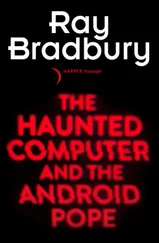If the original cabin on Eight Dollar Mountain was the epitome of spartan, his latest place could easily be described as luxurious. There are massive rock fireplaces and high ceilings; he has electricity now, and a state-of-the-art stereo with speakers in every room. Not exactly the kind of hermit he once was, he now entertains an occasional friend. He even has girlfriends but retains a passionate distaste for the institution of marriage. He still makes his own music—I saw a recorder, a lute, a guitar, and a piano at his house—and one night during my stay he and a girlfriend treated me to a flute duet for several hours. When he needs more intensive solitude, he takes off in one of his planes.
I spent a morning flying around southern Oregon in his Super Cub with him. While he practiced “touch and gos” on isolated mesa tops and tiny airstrips, we talked about his future in the software industry. Or at least, I tried to talk to him about it. Lutus, like many programmers, avoids thinking about long-term or large-scale strategies for securing his position in the industry. Job security was never his goal in the first place. The computer is a device with which he and many programmers have an intensely personal relationship—a relationship that exists independent of their relationship with the software marketplace. They program because programming is in itself pure entertainment for them, and because real life seldom produces the kind of immediate feedback and instant rewards that programming can provide.
Paul needs that kind of relationship, but only as long as it continues to be a liberating rather than a confining force. For that reason, he absolutely rejects any attempt to stereotype or Pigeonhole him. That’s why he devotes so much of his time proving both to himself and to others that he is much more than a rich programmer. He is an aviator, a musician, a political activist, an outdoorsman, a poet. He is utterly himself—irascible, brilliant, iconoclastic—and will not be trapped by the expectations or preconceptions that others may have about him.
One way people liberate themselves from others’ expectations is by acting in as idiosyncratic a manner as possible. Once people define that behavior, however, even idiosyncracy becomes a cage. The existence of rich programmers like Paul proved that unorthodox people who relate to machines better than they get along with people still can be valued by our society. But Paul understands that the myth of the programmer can estrange him from the actual role of programmer. As he says, he is fortunate. His savings permit him to do whatever he likes. He doesn’t have to program for the marketplace, and that feels good because he’s not at all sure that he wants to create for the market, at least not the market that exists now.
Paul has his own inner vision of what the future holds for the software industry, and he’d just as soon program for that market. If the world catches up to him, that’s fine with Paul. But if it doesn’t, that’s okay too. He never specified what the software market of the future looked like in his vision, and in our conversations he didn’t talk about one specific kind of software he planned to produce. We’ll all just have to wait to see what he comes up with next, I guess.
“The rich are different from other people,” Scott Fitzgerald reputedly said: “Yes,” Ernest Hemingway allegedly replied, “they have more money.” By the same token, programmers are different from other people because they know how to write computer programs. For many people, the programming skill is as difficult to grasp and as distant from their daily experience as is fluency in Swahili or the ability to assemble a pocket watch.
But this difference between programmers and nonprogrammers will probably become very blurred in the near future because programming will no longer require facility with the arcane amalgamation of abstruse mathematical calculations and painstaking logical puzzle solving. One key that will help to open the door to this coming populist revolution in software design is an exciting new kind of program, known in the trade as a program generator, that is already on the market. A lot of people in the software industry see these innovative products as the first step toward the creation of a programming-literate population that will number in the millions instead of in the thousands.
Program generators are partially tool-like, partially gamelike, and partially lesson-like. A program generator brings the nonprogramming computer user to an intermediate stage between using a computer program that was written by someone else and generating a computer program of one’s own. This stage is reached not through any formal education in programming principles but by means of a kind of transitional metaphor between the thinking involved in playing a video game and the kind of thinking needed to create a program.
One of the best and most successful program generators was written by a friend of mine named Bill Budge, who has been a legend among Apple programmers since the earliest days of commercial microcomputer software. He is also probably the quintessential representative of the new breed of programmers who see themselves as teachers and artists as well as technicians and craftsmen. He is, in fact, a programmer raised to the level of a pop star. Bill’s current publisher, Electronic Arts, is even promoting him in much the same way that record companies promote their artists—with personal appearances, posters, even full-page magazine ads that display photo portraits of the programmer as culture hero. In one of the first magazine ads on Bill, the copy next to his photograph claimed: “In a bedroom in a frame house in Berkeley, California, a guy who looks like he might have stepped out of a TV series family is playing with some ideas that could change your life.”
Bill does indeed look like he stepped out of “Leave It to Beaver.” He could be one of Wally’s friends, the kind of gangly but good-looking guy who is usually depicted with a basketball under one arm. He could even pass for one of the non-blond minority in a surf movie. Although there is a certain truth to the “nerd mythology” that microcomputer technology was first invented by a bunch of MIT types with thick glasses, bad complexions, and unsuccessful social lives, Bill Budge is evidence of the fact that an obsessive love of computer programming can strike even the tall, dark, and handsome boy next door. ( Softalk , the magazine for Apple owners, once published a fan letter that described Bill as a “hunk.” The letter was later revealed to be a hoax—composed by Corey Kosack, a sixteen-year-old programmer who happened to be doing some work for Brøderbund at the time.) As for the frame house mentioned in the Electronic Arts ad, it too exists, although it is considerably more than the humble student dwelling implied by the ad, and it is actually located in Piedmont, an affluent neighborhood a few miles away from Berkeley.
It is also true that Bill is playing with ideas that are likely to change your life. His tools will put the power of computer programming into the hands of ordinary people. And he has yet to come up against the limits of his abilities. He’s the kind of synthesizer and innovator who takes ideas from dozens of places and weaves them into brilliant and startlingly unexpected patterns. His past programming achievements, and the way he always seems to have his antennae out for sources of new ideas of every kind—from the Egyptian Book of the Dead to theories of dance notation—lead me to expect something even more spectacular from him in the near future. Certainly, Bill will be among those people who are going to make the next decade of the microcomputer software industry even more interesting than the past decade.
Читать дальше










